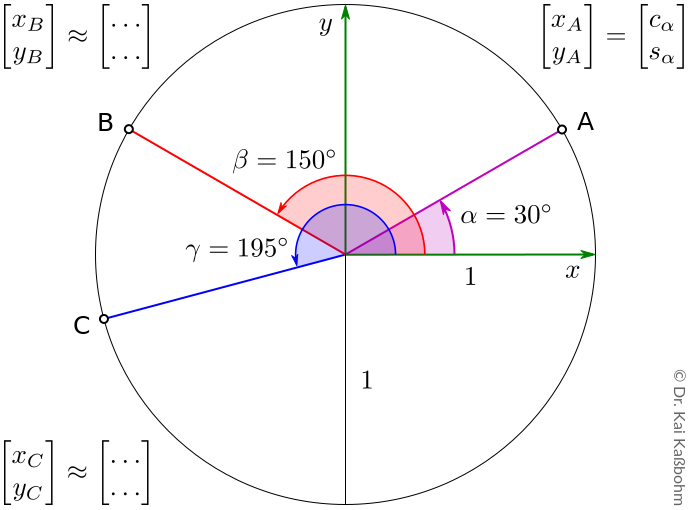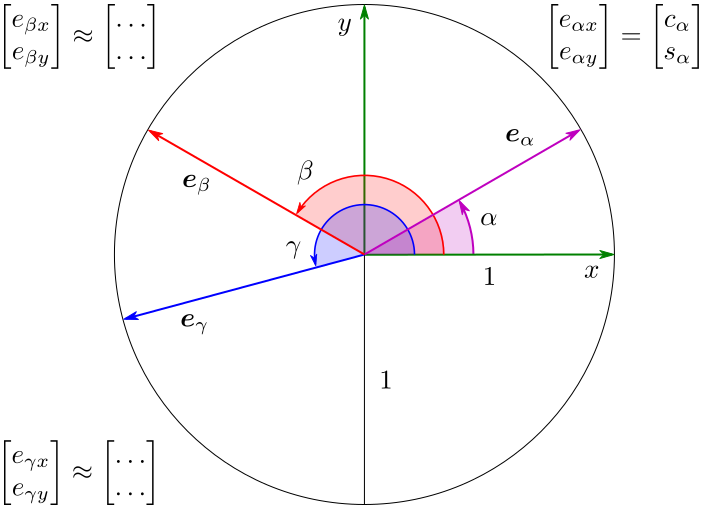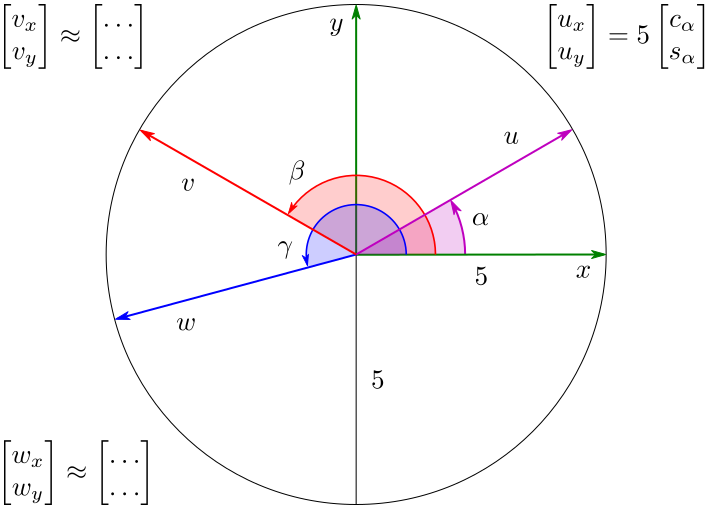M.2.C

Given quantities:
Proceed as follows to learn about how to describe the direction of vectors.
Steps
1. Point Coordinates
Points on the Unit Circle
The coordinates of point A on the unit circle are:
Find the coordinates of the three points A, B and C on the unit circle. Fill in the following table - and round to \(0.01\).
Point |
\(\begin{bmatrix} x \\ y \end{bmatrix}\) |
|---|---|
A |
\(\begin{bmatrix} 0.87 \\ 0.5 \end{bmatrix}\) |
B |
\(\begin{bmatrix} \ldots \\ \ldots \end{bmatrix}\) |
C |
\(\begin{bmatrix} \ldots \\ \ldots \end{bmatrix}\) |
Solution
Point |
\(\begin{bmatrix} x \\ y \end{bmatrix}\) |
|---|---|
A |
\(\begin{bmatrix} 0.87 \\ 0.5 \end{bmatrix}\) |
B |
\(\begin{bmatrix} c_\beta \\ s_\beta \end{bmatrix} \approx \begin{bmatrix} -0.87 \\ 0.5 \end{bmatrix}\) |
C |
\(\begin{bmatrix} c_\gamma \\ s_\gamma \end{bmatrix} \approx \begin{bmatrix} -0.97 \\ -0.26 \end{bmatrix}\) |
2. Unit Vector Components

Components of a Unit Vectors
The \((x,y)\)-components of the unit vector \(\boldsymbol e_\alpha\) sind:
Find the \((x,y)\)-components of the three unit vectors \(\boldsymbol e_\alpha, \boldsymbol e_\beta\) and \(\boldsymbol e_\gamma\). Fill in the following table - and round to \(0.01\).
Unit Vector |
\((x,y)\)-components |
|---|---|
\(\boldsymbol e_\alpha\) |
\(\begin{bmatrix} 0.87 \\ 0.5 \end{bmatrix}\) |
\(\boldsymbol e_\beta\) |
\(\begin{bmatrix} \ldots \\ \ldots \end{bmatrix}\) |
\(\boldsymbol e_\gamma\) |
\(\begin{bmatrix} \ldots \\ \ldots \end{bmatrix}\) |
Solution
Unit Vector |
\((x,y)\)-components |
|---|---|
\(\boldsymbol e_\alpha\) |
\(\begin{bmatrix} 0.87 \\ 0.5 \end{bmatrix}\) |
\(\boldsymbol e_\beta\) |
\(\begin{bmatrix} c_\beta \\ s_\beta \end{bmatrix} \approx \begin{bmatrix} -0.87 \\ 0.5 \end{bmatrix}\) |
\(\boldsymbol e_\gamma\) |
\(\begin{bmatrix} c_\gamma \\ s_\gamma \end{bmatrix} \approx \begin{bmatrix} -0.97 \\ -0.26 \end{bmatrix}\) |
3. Vector Components

Components of a Vector
The \((x,y)\)-components of the vector \(\boldsymbol u\) are:
Find the \((x,y)\)-components of the three vectors \(\boldsymbol u, \boldsymbol v\) and \(\boldsymbol w\). Fill in the following table - and round to \(0.01\).
Vector |
\((x,y)\)-components |
|---|---|
\(\boldsymbol u\) |
\(\begin{bmatrix} 4.33 \\ 2.5 \end{bmatrix}\) |
\(\boldsymbol v\) |
\(\begin{bmatrix}\ldots\\ \ldots \end{bmatrix}\) |
\(\boldsymbol w\) |
\(\begin{bmatrix}\ldots\\ \ldots \end{bmatrix}\) |
Solution
Vector |
\((x,y)\)-components |
|---|---|
\(\boldsymbol u\) |
\(\begin{bmatrix} 4.33 \\ 2.5 \end{bmatrix}\) |
\(\boldsymbol v\) |
\(5 \begin{bmatrix} c_\beta \\ s_\beta \end{bmatrix} \approx \begin{bmatrix} -4.33 \\ 2.5 \end{bmatrix}\) |
\(\boldsymbol w\) |
\(5\begin{bmatrix} c_\gamma \\ s_\gamma \end{bmatrix} \approx \begin{bmatrix} -4.83 \\ -1.29 \end{bmatrix}\) |